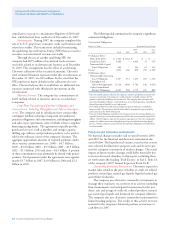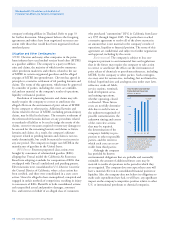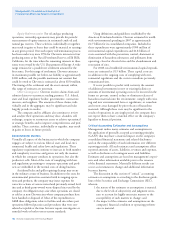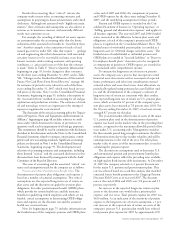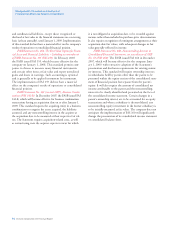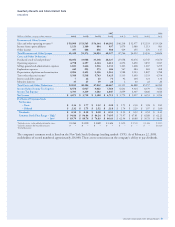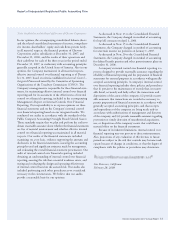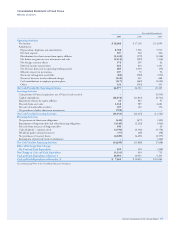Chevron 2007 Annual Report Download - page 49
Download and view the complete annual report
Please find page 49 of the 2007 Chevron annual report below. You can navigate through the pages in the report by either clicking on the pages listed below, or by using the keyword search tool below to find specific information within the annual report. 47
Besides those meeting these “critical” criteria, the
company makes many other accounting estimates and
assumptions in preparing its financial statements and related
disclosures. Although not associated with “highly uncertain
matters,” these estimates and assumptions are also subject to
revision as circumstances warrant, and materially different
results may sometimes occur.
For example, the recording of deferred tax assets requires
an assessment under the accounting rules that the future
realization of the associated tax benefits be “more likely than
not.” Another example is the estimation of crude oil and
natural gas reserves under SEC rules that require “… geologi-
cal and engineering data (that) demonstrate with reasonable
certainty (reserves) to be recoverable in future years from
known reservoirs under existing economic and operating
conditions, i.e., prices and costs as of the date the estimate
is made.” Refer to Table V, “Reserve Quantity Information,”
beginning on page 93, for the changes in these estimates
for the three years ending December 31, 2007, and to Table
VII, “Changes in the Standardized Measure of Discounted
Future Net Cash Flows From Proved Reserves” on page 101
for estimates of proved-reserve values for each of the three
years ending December 31, 2007, which were based on year-
end prices at the time. Note 1 to the Consolidated Financial
Statements, beginning on page 59, includes a description of
the “successful efforts” method of accounting for oil and gas
exploration and production activities. The estimates of crude
oil and natural gas reserves are important to the timing of
expense recognition for costs incurred.
The discussion of the critical accounting policy for “Impair-
ment of Properties, Plant and Equipment and Investments in
Affiliates,” beginning on page 48, includes reference to condi-
tions under which downward revisions of proved-reserve
quantities could result in impairments of oil and gas properties.
This commentary should be read in conjunction with disclosures
elsewhere in this discussion and in the Notes to the Consolidated
Financial Statements related to estimates, uncertainties, contin-
gencies and new accounting standards. Significant accounting
policies are discussed in Note 1 to the Consolidated Financial
Statements, beginning on page 59. The development and
selection of accounting estimates and assumptions, including
those deemed “critical,” and the associated disclosures in this
discussion have been discussed by management with the Audit
Committee of the Board of Directors.
The areas of accounting and the associated “critical” esti-
mates and assumptions made by the company are as follows:
Pension and Other Postretirement Benefit Plans The
determination of pension plan obligations and expense is
based on a number of actuarial assumptions. Two critical
assumptions are the expected long-term rate of return on
plan assets and the discount rate applied to pension plan
obligations. For other postretirement benefit (OPEB) plans,
which provide for certain health care and life insurance
benefits for qualifying retired employees and which are not
funded, critical assumptions in determining OPEB obliga-
tions and expense are the discount rate and the assumed
health care cost-trend rates.
Note 20, beginning on page 75, includes information on
the funded status of the company’s pension and OPEB plans
at the end of 2007 and 2006; the components of pension
and OPEB expense for the three years ending December 31,
2007; and the underlying assumptions for those periods.
Pension and OPEB expense is recorded on the Con-
solidated Statement of Income in “Operating expenses” or
“Selling, general and administrative expenses” and applies to
all business segments. The year-end 2007 and 2006 funded
status, measured as the difference between plan assets and
obligations, of each of the company’s pension and OPEB
plans is recognized on the Consolidated Balance Sheet. The
funded status of overfunded pension plans is recorded as a
long-term asset in “Deferred charges and other assets.” The
funded status of underfunded or unfunded pension and
OPEB plans is recorded in “Accrued liabilities” or “Reserves
for employee benefit plans.” Amounts yet to be recognized
as components of pension or OPEB expense are recorded in
“Accumulated other comprehensive income.”
To estimate the long-term rate of return on pension
assets, the company uses a process that incorporates actual
historical asset-class returns and an assessment of expected
future performance and takes into consideration external
actuarial advice and asset-class factors. Asset allocations are
periodically updated using pension plan asset/liability stud-
ies, and the determination of the company’s estimates of
long-term rates of return are consistent with these studies.
The expected long-term rate of return on U.S. pension plan
assets, which account for 67 percent of the company’s pen-
sion plan assets, has remained at 7.8 percent since 2002. For
the 10 years ending December 31, 2007, actual asset returns
averaged 8.7 percent for this plan.
The year-end market-related value of assets of the major
U.S. pension plan used in the determination of pension
expense was based on the market value in the preceding three
months, as opposed to the maximum allowable period of five
years under U.S. accounting rules. Management considers
the three-month period long enough to minimize the effects
of distortions from day-to-day market volatility and still be
contemporaneous to the end of the year. For other plans,
market value of assets as of the measurement date is used in
calculating the pension expense.
The discount rate assumptions used to determine U.S.
and international pension and postretirement benefit plan
obligations and expense reflect the prevailing rates available
on high-quality fixed-income debt instruments. At December
31, 2007, the company selected a 6.3 percent discount rate
for the major U.S. pension and postretirement plans. This
rate was selected based on a cash flow analysis that matched
estimated future benefit payments to the Citigroup Pension
Discount Yield Curve as of year-end 2007. The discount
rates at the end of 2006 and 2005 were 5.8 percent and 5.5
percent, respectively.
An increase in the expected long-term return on plan
assets or the discount rate would reduce pension plan
expense, and vice versa. Total pension expense for 2007 was
$620 million. As an indication of the sensitivity of pension
expense to the long-term rate of return assumption, a 1 per-
cent increase in the expected rate of return on assets of the
company’s primary U.S. pension plan would have reduced
total pension plan expense for 2007 by approximately $70







